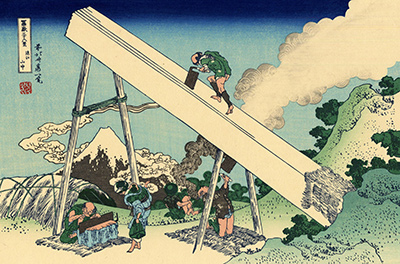Hokusai
Mount Fuji from the Mountains of Totomi by Hokusai
The mention of the Volcano Mount Fuji in the art history of Japan was very popular due to its cultural and religious significance. Katsushika Hokusai himself had a huge obsession with this mountain based on the tradition that the mountain was a secret to immortality.
Hokusai, therefore, came up with the Ukiyo series that had the Thirty-Six View of Mount Fuji (Fugaku) prints and the Mount Fuji from the Mountains of Totomi artwork is one of them. In fact, much, later on, there was an addition of ten more to make it forty-six after he had quit drawing. The series depicts Mount Fuji from different locations, weathers and various seasons. The series was produced between c. 1830 to 1835. There are other subsequent works such as the Hiroshige’s series Thirty-six Views of Mount Fuji and another book called one Hundred Views of Mount Fuji.
Mount Fuji from the Mountains of Totomi was produced in c.1831 with an intention of trying to depict Mount Fuji from the Totomi Mountains just as the name suggests. The medium used for the print was woodblock; color on paper during the historical Edo Period. Katsushika Hokusai painted the print in Japan. Just like in the other prints in the thirty-six series, the Mount Fuji from the Mountains of Totomi features a human figure engaged in an activity.
The artist uses a theatrical technique to stage-manage the natural setting to match the figure that is on stage. The series was produced when Hokusai was in his seventies and at the height of his career and was produced by Nishimura Yohachi. Even though it’s not very clear about his date of birth, historians suggest that he was born on October 31st, 1760 and died on May 10th 1849 in Japan. Hokusai is an artist who seems to reappear again and again because he had a unique impact in regards to his enormous vitality, longevity, a conventional display of society and an eager quest to convey maturity in his artwork.
